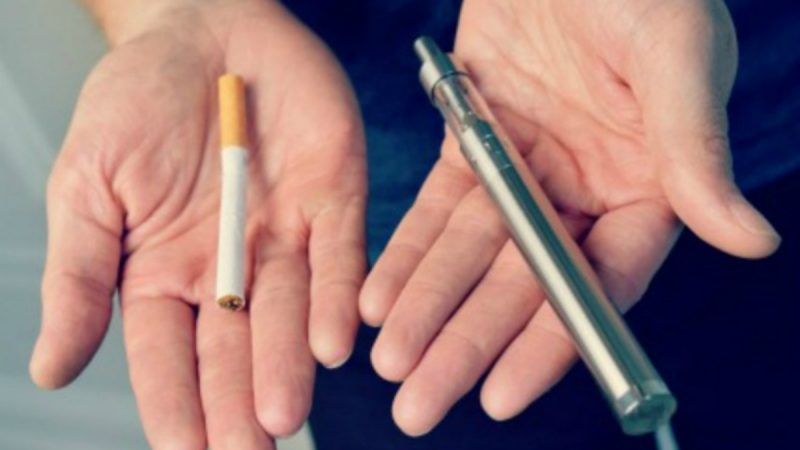If Less Vaping Means More Smoking, That Won't Be a Public Health Victory
Cigarette sales rose last year for the first time in two decades, while a survey of high school seniors found they were vaping less but smoking more.

Cigarette sales in the United States rose last year for the first time in two decades, according to data published by the Federal Trade Commission this week. Although the 0.4 percent increase may be due at least partly to smokers who stocked up on cigarettes during the COVID-19 pandemic, it coincided with declines in e-cigarette use by teenagers and adults—a potential warning sign that the campaign against vaping is undermining public health by boosting cigarette consumption.
In 2020, despite the increase in cigarette purchases, it looks like the percentage of adults who smoked continued a long decline that began in the 1960s. The prevalence of "current cigarette smoking" among Americans 18 or older was about 13 percent last year, according to preliminary numbers from the National Health Interview Survey, down from 14 percent in 2019 and more than 40 percent in 1965. The same survey found that the prevalence of "current electronic cigarette use" among adults fell from 4.5 percent in 2019 to less than 4 percent in 2020.
The Monitoring the Future Study, by contrast, found that the prevalence of past-month cigarette smoking among high school seniors rose by 32 percent last year, from 5.7 percent in 2019 to 7.5 percent in 2020. That jump, which coincided with a drop in vaping that followed three consecutive years of increases, was a striking departure from the downward trend in adolescent cigarette smoking that began in the late 1990s. Since 1997, when 36.5 percent of 12th-graders said they had smoked cigarettes in the previous month, that rate had fallen or remained steady every year except 2004, when it rose by 2.4 percent before resuming the downward trend.
While we should not make too much of one year's data, these results are consistent with the hypothesis that vaping has been replacing smoking among teenagers. Drawing on data from several surveys, a 2018 study in the journal Tobacco Control found that the decline in adolescent smoking accelerated as vaping became more popular. A 2021 study in The Journal of the American Medical Association found evidence that San Francisco's 2018 ban on flavored e-cigarettes boosted smoking by teenagers and young adults. The implication is that policies aimed at preventing underage vaping, to the extent that they make e-cigarettes less appealing, more expensive, or harder to obtain, perversely encourage consumption of a much more hazardous product.
Like the Monitoring the Future Study, the National Youth Tobacco Survey (NYTS) found that the decline in adolescent smoking continued as adolescent vaping rose. Between 2016 and 2019, for example, the prevalence of past-month vaping among high school students rose from 11.3 percent to 27.5 percent, while the prevalence of past-month cigarette smoking fell from 8 percent to 5.8 percent. The vaping rate fell to 19.6 percent in 2020 and 11.3 percent in 2021—a 59 percent drop over two years. While the smoking rate fell to 4.6 percent in 2020, the number for 2021 has not been published yet.
The fact that the Centers for Disease Control and Prevention (CDC), which oversees the NYTS, chose to release the 2021 e-cigarette data first reflects its determination to maintain public alarm about adolescent vaping. The Food and Drug Administration (FDA) cited the e-cigarette numbers as justification for its heavy-handed regulation of the vaping industry, including its bias against the e-liquid flavors that former smokers overwhelmingly prefer. Neither agency acknowledged the sharp decline in e-cigarette use by teenagers. And because the CDC has not shown us the rest of the NYTS results yet, we don't know whether that drop coincided with an increase in adolescent smoking, which would cast further doubt on the wisdom of the policies the CDC and FDA favor.
In addition to legal restrictions, those policies include propaganda that deliberately obscures the enormous difference between the health risks posed by vaping and the health risks posed by smoking. While the FDA acknowledges the harm-reducing potential of e-cigarettes, its alarmist messages to teenagers imply that vaping is actually more dangerous than smoking. For years activists and public officials have been minimizing, ignoring, or denying the potentially lifesaving benefits of switching from smoking to vaping. As a result, Americans are increasingly confused about the relative hazards of the two habits.
Between 2012 and 2017, according to a 2019 analysis of results from two national surveys, the share of respondents who correctly perceived e-cigarettes as less dangerous than the conventional, combustible kind fell from 51 percent to 35 percent in one survey and from 39 percent to 34 percent in the other. Meanwhile, the share who incorrectly thought vaping is just as hazardous as smoking rose from 46 percent to 56 percent and from 12 percent to 36 percent, respectively. The percentage who erroneously believed that vaping is more dangerous than smoking tripled in both surveys, reaching nearly 10 percent in one and more than 4 percent in the other.
A subsequent survey suggested that misinformation about a spate of lung injuries caused by black-market THC vapes, which the CDC irresponsibly encouraged the public to associate with nicotine products, caused further confusion. Two Morning Consult polls found that the percentage of Americans who understood that vaping is less hazardous than smoking fell by 14 points between June 2018 and September 2019.
Scaring people away from vaping by exaggerating its hazards is not just dishonest and unethical; it is also counterproductive from a public health perspective. If the resulting declines in e-cigarette use lead to more smoking than otherwise would have occurred, the upshot will be more tobacco-related morbidity and mortality, the opposite of what the CDC and the FDA supposedly are trying to achieve.


Show Comments (18)